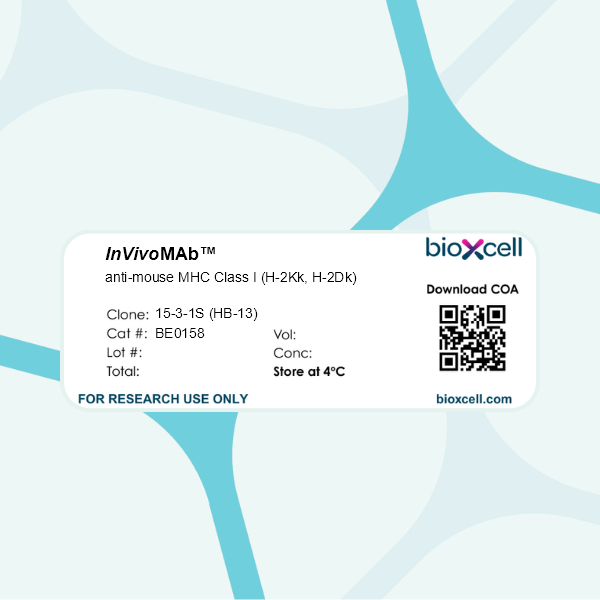InVivoMAb anti-mouse MHC Class I (H-2Kk, H-2Dk)
Product Description
Specifications
| Isotype | Mouse IgG2a, κ |
|---|---|
| Recommended Isotype Control(s) | InVivoMAb mouse IgG2a isotype control, unknown specificity |
| Recommended Dilution Buffer | InVivoPure pH 7.0 Dilution Buffer |
| Conjugation | This product is unconjugated. Conjugation is available via our Antibody Conjugation Services. |
| Immunogen | C3H mouse spleen cells |
| Reported Applications |
in vivo administration Flow cytometry |
| Formulation |
PBS, pH 7.0 Contains no stabilizers or preservatives |
| Endotoxin |
≤1EU/mg (≤0.001EU/μg) Determined by LAL assay |
| Purity |
≥95% Determined by SDS-PAGE |
| Sterility | 0.2 µm filtration |
| Production | Purified from cell culture supernatant in an animal-free facility |
| Purification | Protein G |
| RRID | AB_10949183 |
| Molecular Weight | 150 kDa |
| Storage | The antibody solution should be stored at the stock concentration at 4°C. Do not freeze. |
| Need a Custom Formulation? | See All Antibody Customization Options |
Application References
in vivo administration
Hirohashi, T., et al. (2012). "A novel pathway of chronic allograft rejection mediated by NK cells and alloantibody" Am J Transplant 12(2): 313-321.
PubMed
Chronic allograft vasculopathy (CAV) in murine heart allografts can be elicited by adoptive transfer of donor specific antibody (DSA) to class I MHC antigens and is independent of complement. Here we address the mechanism by which DSA causes CAV. B6.RAG1(-/-) or B6.RAG1(-/-)C3(-/-) (H-2(b)) mice received B10.BR (H-2(k)) heart allografts and repeated doses of IgG2a, IgG1 or F(ab’)(2) fragments of IgG2a DSA (anti-H-2(k)). Intact DSA regularly elicited markedly stenotic CAV in recipients over 28 days. In contrast, depletion of NK cells with anti-NK1.1 reduced significantly DSA-induced CAV, as judged morphometrically. Recipients genetically deficient in mature NK cells (gamma-chain knock out) also showed decreased severity of DSA-induced CAV. Direct NK reactivity to the graft was not necessary. F(ab’)(2) DSA fragments, even at doses twofold higher than intact DSA, were inactive. Graft microvascular endothelial cells responded to DSA in vivo by increased expression of phospho-extracellular signal-regulated kinase (pERK), a response not elicited by F(ab’)(2) DSA. We conclude that antibody mediates CAV through NK cells, by an Fc dependent manner. This new pathway adds to the possible mechanisms of chronic rejection and may relate to the recently described C4d-negative chronic antibody-mediated rejection in humans.
Flow Cytometry
Sheng-Tanner, X., et al. (2000). "Characterization of graft-versus-host disease in SCID mice and prevention by physicochemical stressors" Transplantation 70(12): 1683-1693.
PubMed
BACKGROUND: Graft versus host disease (GVHD) prevents potentially curative allogeneic stem cell transplantation from being offered to cancer patients who lack a suitably matched donor. New methods to prevent GVHD are required to allow successful transplants across major histocompatibility complex barriers. METHODS: A model of GVHD in C.B-17 SCID mice was developed to allow the study of allo-activated donor T cells without confounding effects of host lymphocytes. The abilities of cyclosporin-A, anticytokine antibodies, and oxidative stress to prevent GVHD in this model was studied. RESULTS: T cells from major histocompatibility-mismatched donor mice caused severe GVHD in sublethally irradiated SCID hosts that could be ameliorated by coadministration of donor bone marrow but not by cyclosporine-A or anticytokine antibodies. In contrast, three-log more T cells could be injected without clinical consequences if they had been pretreated with a combination of heat, ultraviolet light, and oxygenation. The effect was not the trivial result of donor T cell destruction because T cell reconstitution, although delayed, recovered to normal levels within 2 weeks. Protection from GVHD required oxygenation and was associated with normalization of the CD4/CD8 donor T cell ratio, recovery of host hematopoiesis, and decreased inflammatory cytokine production. CONCLUSION: Pretreatment of donor T cells with a combination of physicochemical stressors effectively prevents GVHD caused by major major histocompatibility disparities and may facilitate the safe transplantation of patients without HLA-identical donors.

